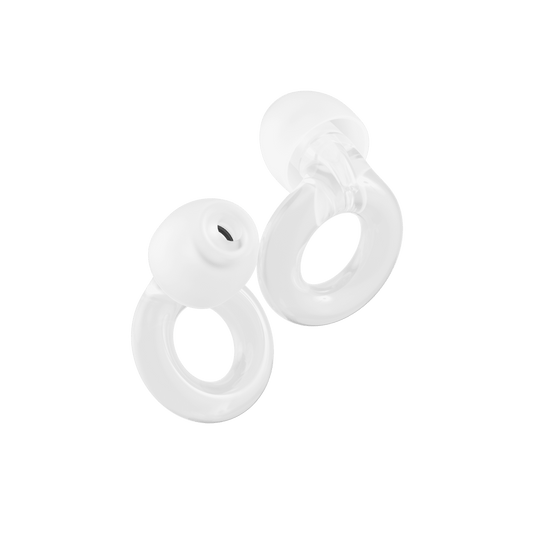Decibels are how we measure sound – and understanding how they work can help you to better protect your hearing. Let’s take a look at everything you need to know about decibels, from key questions like what is a safe decibel level to how to keep your ears safe when decibel levels are high.
Key takeaways:
- Decibels (dB) measure sound intensity.
- The decibel scale is logarithmic, meaning small changes in dB represent big differences in sound.
- Sounds above 85 dB can cause hearing damage with prolonged exposure.
- Earplugs can protect hearing in noisy environments.
What is a decibel?
A decibel (dB) is a unit of measurement – but what is a decibel a measure of? In short, it’s the standard unit that’s used to measure the intensity of sound. They help us to understand how loud or quiet a sound is, in a way that’s easy to compare.
By standardizing sound measurements through decibels, we can better understand and compare the relative intensity of sounds across different environments. Whatever sound you’re measuring, from the quiet hum of a fan to the roar of a jet engine, decibels offer a clear and consistent way to understand how intense these sounds are. This better enables us to set noise limits and protect our hearing, and it’s also important for industries like music and engineering, where precise sound measurements are crucial.
Understanding decibels and sound intensity also helps each of us to better understand risk levels and take appropriate measures to protect our hearing in noisy environments.
Understanding the decibel scale
They operate on a logarithmic scale, which means that small changes in decibels can represent significant differences in sound levels. That means that an increase of 10 decibels represents a tenfold increase in sound intensity. On the decibel scale, 0 dB is the quietest sound a human ear can hear, typically considered to be close to near-silence.
Then, a sound at 10 dB is ten times more intense than a sound at 0 dB, a sound that’s 20 dB is ten times more intense than a sound that measures 10 dB, while a sound measured at 30 dB is 100 times more intense than a 10 dB sound.
This human ear can hear a vast range of sounds, from whispers to jet engines. If sound was measured on a linear scale, it’d be impossible to capture the full spectrum of sounds, as the numbers would be enormous.
By using a logarithmic scale, the decibel system compresses this wide range into smaller, more intuitive increments. This makes it much easier to compare sounds of different intensities. Although the difference in sound intensity between a quiet library (roughly 40 dB) and 100 dB (a nightclub) is huge, the logarithmic scale represents it clearly and makes it easy to conceptualize. The numbers on the decibel scale are proportional to how we perceive changes in loudness, so even though the underlying intensity difference is massive, the scale reflects our experience in a way that feels intuitive.
Common examples of decibel levels
So, what does that look like in real terms? Some examples of sound levels include:
- Rustling leaves: around 10 decibels, which is barely audible to the human ear
- Whispering: around 20 dB, which is ten times louder than rustling leaves
- A quiet library: around 40 dB, which is 100 times louder than a whisper
- A vacuum cleaner: around 70 dB, which is 1,000 times more intense than a quiet library.
All of these are normal everyday sounds, and won’t cause hearing damage. But when sounds are 85 decibels or above, that’s when they can potentially cause hearing damage:
- At 85 dB (imagine heavy city traffic): There’s the risk of hearing damage after more than 8 hours of exposure without hearing protection
- At 91 dB (think of a loud car radio): Hearing damage is possible after 2 hours without hearing protection
- At 100 decibels (the noise level of a nightclub): Hearing damage is possible after just 15 minutes without hearing protection
- 120 dB (like a loud alarm or siren): This can cause immediate damage without hearing protection
Featured collection
-
Experience 2 Plus
SaleRegular price €39.95Regular priceUnit price per
Why decibels matter for hearing health
Exposure to noises over 85 decibels, then, can cause hearing damage if you don’t use hearing protection. Nightclubs are around 100 decibels, so if you spend just 15 minutes clubbing without using any hearing protection, you run the risk of hearing damage.
It’s also important to know that hearing damage isn’t just caused by how loud a sound is – the amount of time you’re exposed to loud noise is also a key factor in hearing damage. 85 decibels is equivalent to heavy city traffic – which might not sound that loud. But if you’re exposed to it for 8 hours without any hearing protection, you could damage your hearing.
Additionally, your proximity to noise can also affect the likelihood of hearing damage. If you’re right up close to the speakers in a nightclub, for example, you run the risk of hearing damage faster than if you’re hanging out at the back of the club – although there’s no denying that nightclubs are loud, no matter where you’re standing.
Protecting your ears from excessive noise
Using noise-reducing earplugs is a great way to reduce your exposure to loud noises, helping you to keep your ears safe and reduce your risk of tinnitus.
Loop Experience earplugs are made for live concerts and events. They have an innovative acoustic filter that reduces noise by 17 dB (SNR) – or an extra 3 dB (SNR) with Loop Experience Plus – while keeping the sound crystal clear. That means you can still enjoy concerts, sports, and other live events – just at a safer volume.
As well as being a risk to your hearing, noisy environments can also cause stress and anxiety, especially if you have misophonia or are noise sensitive. Loop Engage earplugs take the edge off for more calm and focus when life gets too loud, and also offer discreet relief from everyday noise for more clear and focused conversations, with 16 dB (SNR) of noise reduction – or an extra 9 dB (SNR) with Loop Engage Plus earplugs.
The other big risk of noisy environments? As well as damaging your hearing, they can be distracting. Loop Quiet earplugs muffle distractions to get in the zone and maximize your productivity, with 24 dB (SNR) of noise reduction to help you get in your quiet bubble – or 27 dB (SNR) with Quiet 2 Plus’ Loop Double Tips.
The value of understanding decibels
Decibels are used to measure the intensity of sound – so by understanding what decibels represent, you’ll be able to better recognize potentially dangerous noise levels, and take steps to manage your noise exposure in daily life. That might mean becoming more aware when noise levels are too high, or understanding the situations in which hearing protection is necessary.
Taking proactive steps to monitor the noise levels in your environment can help to make a big difference when it comes to protecting your hearing. One easy way to do that is by using earplugs like Loop Experience for concerts to reduce noise to a safer volume, while keeping sound clear – so you can still enjoy events to the fullest. After all, protecting your ears today ensures you can continue enjoying the sounds today, tomorrow – and for many years to come.












